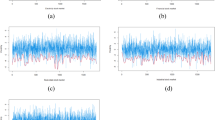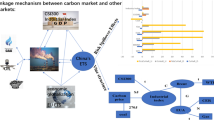Abstract
Measuring the risks of the carbon financial market is of great significance for investment decision-making, risk supervision, and the healthy development of the carbon trading market. Different from previous studies based on traditional VaR (value at risk), this study measures the integrated risk of China’s carbon market based on the Copula-EVT (Extreme Value Theory) -VaR model which can explore the unique strength of the copula and EVT-VaR models, of which the copula model is applied to capture the dependence between the different risk factors of carbon price volatility and macroeconomic fluctuation, while the EVT-VaR is used to explore the risk value. The empirical results show that the traditional VaR that only considers a single risk factor from carbon price volatility is likely to overestimate the risk. In addition, compared with other methods that do not consider the interdependence between risk factors, using the copula function to measure the carbon market integration risk is more effective, and backtesting also confirms this conclusion. This paper provides a specific reference for carbon emission companies to participate in the carbon market. It provides a theoretical basis for the supervision of the risk management of the carbon market.











Similar content being viewed by others
References
Berkes I, Horváth L, Kokoszka P (2003) GARCH processes: structure and estimation. Bernoulli 9(2):201–227
Chevallier J (2010) Detecting instability in the volatility of carbon prices. Energy Economics 33(1):99–110
Corcoran JN (2002) Modelling extremal events for insurance and finance. J Am Stat Assoc 97(457):360–360
Dou Y, Li Y, Dong K, Ren X (2022) Dynamic linkages between economic policy uncertainty and the carbon futures market: does Covid-19 pandemic matter? Resources Policy. 75.
DuMouchel WH (1983) Estimating the stable index α in order to measure tail thickness: a critique. Ann Stat 11(4):1019–1031
Engle R (2001) GARCH 101: the use of ARCH/GARCH models in applied econometrics. Journal of Economic Perspectives 15(4):157–168
Feng Z, Wei Y, Wang K (2012) Estimating risk for the carbon market via extreme value theory: an empirical analysis of the EU ETS. Appl Energy 99:97–108
Fu Y, Zheng Z (2020) Volatility modeling and the asymmetric effect for China’s carbon trading pilot market. Physica A: Statistical Mechanics and its Applications. 542(C).
Ji C, Hu Y, Tang B, Qu S (2021) Price drivers in the carbon emissions trading scheme: evidence from Chinese emissions trading scheme pilots. Journal of Cleaner Production.278.
Khan Z, Murshed M, Dong K (2021) The roles of export diversification and composite country risks in carbon emissions abatement: evidence from the signatories of the regional comprehensive economic partnership agreement. Applied Economics.53.
Kupiec PH (1995) Techniques for verifying the accuracy of risk measurement models. The Journal of Derivatives 3(2):73–84
Liu H, Shi J (2013) Applying ARMA–GARCH approaches to forecasting short-term electricity prices. Energy Economics 37:152–166
Marc G, Janina K, Stefan T (2011) The relationship between carbon, commodity and financial markets: a copula analysis. Economic Record 87(s1):105-124
Marimoutou V, Raggad B, Trabelsi A (2009) Extreme value theory and VaR: application to oil market. Energy Economics 31(4):519–530
McNeil AJ, Frey R (2000) Estimation of tail-related risk measures for heteroscedastic financial time series: an extreme value approach. J Empir Financ 7(3):271–300
Nelson DB (1990) Stationarity and persistence in the GARCH(1,1) model. Economet Theor 6(3):318–334
Panorska AK (1995) Stable GARCH models for financial time series. Appl Math Lett 8(5):33–37
Qiu H, Hu G, Yang Y, Zhang J, Zhang T (2020) Modeling the risk of extreme value dependence in Chinese regional carbon emission markets. Sustainability 12(19):7911–7911
Reboredo JC, Ugando M (2015) Downside risks in EU carbon and fossil fuel markets. Math Comput Simul 111:17–35
Segnon M, Lux M, Gupta R (2016) Modeling and forecasting the volatility of carbon dioxide emission allowance prices: a review and comparison of modern volatility models. Renew Sustain Energy Rev 69:692–704
Shahbaz M, Li J, Dong X, Dong K (2022) How financial inclusion affects the collaborative reduction of pollutant and carbon emissions: the case of China. Energy Economics.107.
Sklar A (1959) Fonctions de Repartition a n Dimensions et Leurs Marges. Publications De L’ Institut De Statistique De L’universite De Paris 8:229–231
Wen F, Zhao L, He S, Yang G (2020) Asymmetric relationship between carbon emission trading market and stock market: evidences from China. Energy Economics.91.
Yang B, Liu C, Gou Z, Man J, Su Y (2018) How will policies of China’s CO2 ETS affect its carbon price: evidence from Chinese pilot regions. Sustainability 10(3):605
Zhang X, Li J (2018) Credit and market risks measurement in carbon financing for Chinese banks. Energy Economics 76:549–557
Zhang Y, Sun Y (2016) The dynamic volatility spillover between European carbon trading market and fossil energy market. J Clean Prod 112:2654–2663
Zhang C, Yang Y, Yun P (2020) Risk measurement of international carbon market based on multiple risk factors heterogeneous dependence. Financ Res Lett 32:1–10
Zhang J, Xu Y (2020) Research on the price fluctuation and risk formation mechanism of carbon emission rights in China based on a GARCH model. Sustainability. 12(10):4249–.
Zhu B, Ye S, He K, Chevallier J, Xie R (2019) Measuring the risk of European carbon market: an empirical mode decomposition-based VaR approach. Ann Oper Res 281(1–2):373–395
Author information
Authors and Affiliations
Contributions
All authors contributed to the study conception and design. Material preparation, data collection, and analysis were performed by XW and LY. The first draft of the manuscript was written by LY, and all authors commented on previous versions of the manuscript. All authors read and approved the final manuscript.
Corresponding author
Ethics declarations
Ethics approval
This article does not contain any studies with human participants or animals performed by any of the authors.
Consent to participate
Informed consent was obtained from all individual participants included in the study.
Consent for publication
All individual participants consent to publish this article.
Competing interests
The authors declare no competing interests.
Additional information
Responsible Editor: Arshian Sharif
Publisher's note
Springer Nature remains neutral with regard to jurisdictional claims in published maps and institutional affiliations.
Rights and permissions
About this article
Cite this article
Wang, X., Yan, L. Measuring the integrated risk of China’s carbon financial market based on the copula model. Environ Sci Pollut Res 29, 54108–54121 (2022). https://doi.org/10.1007/s11356-022-19679-w
Received:
Accepted:
Published:
Issue Date:
DOI: https://doi.org/10.1007/s11356-022-19679-w




